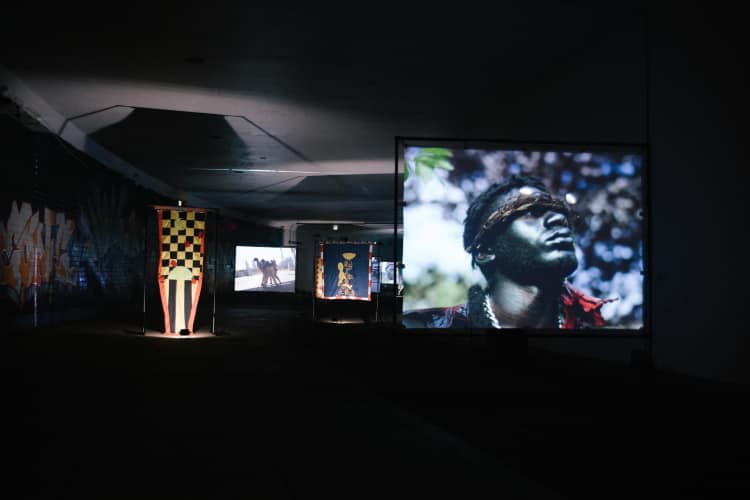How Akinola Davies Jr is exploring the reclamation of African artifacts
An interview with the artist also known as Crack Stevens on his latest work and first U.S. solo exhibition, H.O.D.

It’s a stereotypically cloudy London afternoon when I meet visual artist Akinola Davies Jr., who’s stepped away from his studio to chat at a cafe in Dalston. He's putting the final touches on H.O.D, his first U.S. solo exhibition which opened late last month at Washington D.C.’s Dupont Underground, and is produced and presented by sketchedSPACE, a Seoul-based arts entity driven by cultural hybridity. Through a short experimental film and a sequence of totemic flags, Davies's exhibition tells the story of a reclamation of African artifacts from the West through ritual.
Davies’s catalogue of experimental films and exhibitions explore individual and communal identities by altering the physical and emotional context they're presented within. In 2017’s Permission, a short film in collaboration with fashion designer Bianca Saunders, Davies and Saunders explore black male masculinity is through a series of touches, embraces, and trust falls; In the music videos Davies has directed for artists like Dev Hynes (most recently “Charcoal Baby”), Larry B, and Klein, traditions and rituals are distorted as a means to define and challenge them. Most recently, his Spring 2018 solo exhibition Boot/Leg documented how counterfeit garments influence runway designs by centering the stylish young folks who wear the braggadocious knock-offs.
Davies’s interests in the value and repossession of objects carry into H.O.D. Over a cup of fresh mint tea, he explains his unsettling encounters with African artifacts at British museums since moving to England as a teenager. “I'd go there and the Africa room is in the basement. A lot of the artifacts and objects in there, the little texts that would accompany, it just seemed like [the museums] were making it up or just guessing what [the items were].” The displacement and misinterpretation of those objects launch the mythology of reclamation he weaves into H.O.D, where caretakers arrive in London to reclaim the objects. “When I conceived the film, I wanted them to go the museum and claim stuff back — but you can't shoot in a museum and we didn't have a budget to make something that big. So it had to just be the idea of them arriving.”
Davies found his way to London after immigrating from Lagos, Nigeria as a teen, spending his first few years in England’s countryside. Displacement and the distortion that it causes are intimately familiar to him; as we walk out of the cafe, he points out a congregation of couriers for different app-based delivery services as they convene while waiting for their next order. A block later, he runs into a collaborator who worked on H.O.D with him. In London, the artist has found the perfect city where his fascination with displacement and its antidote — community — can be elaborated on.
Tell me about how H.O.D came together.
I saw Kerry James Marshall do a really interesting Tate Talk not too long ago. Someone asked about his comic book Rythm Mastr, "How important was it for members of the global diaspora or the diaspora to create art and mythology and add to our own mythologies?" He thinks it's crucial to do so — that way we can give a more honest, open, and nuanced portrayal of ourselves, our existence, and the things that matter to us. Our mythologies are not submissive to anyone else who creates their own mythology for us.
I also saw a conversation between Arthur Jafa and Kahlil Joseph at the Tate. I've known of [Jafa’s] work but never seen or heard him talk. Kahlil was quite shy and reserved, and then Arthur came on stage and sounded like a crazy uncle full of conspiracy theories, which I immediately fell in love with. He crystallized the idea about African art coming into Europe in the earlier 20th century, how artists met these alien objects, and how it informed their process.
How did these two conversations shape H.O.D?
These objects in Nigeria and West Africa were servicing community. They weren't just beautiful carvings that people made for art — they were things that people prayed to or sought solace in. My thing was, I'd like to take all these things back. That's always my reaction when I'm in that space. If I'm making a film that's personal to me, I want to create a mythology that contributes towards claiming these things back. I can't actually go to the museum and actually take them back, so I'm going to create a mythology about these custodians coming to claim them back.
You've talked about feeling alien in your experience living in England and going back to Nigeria after having done so. Can you elaborate on that?
I used to do a radio show on NTS centered around mental health and the welfare of the creative community. Being raised in Africa and coming over here, the conversation of mental health seemed non-existent within African communities. My thing was, Why doesn't this exist? There's a chain of thought to suggest that when people are displaced, they tend to have aversion psychosis because they're literally displaced, so they don't know where their anchors are. For me, that feeling of feeling alien started playing on my mental health. I grew up in Nigeria, and I was always presented as this kind of binary.
What do you mean by that?
I grew up in Lagos until I was 13. I went to church two or three times a week. Nigeria was under a military dictatorship, so there was a lot of censorship at the time — but I was a bit too young to really understand that. You're told, This is how you're supposed to be. You're going to go to school. You're going to become this lawyer, [work in] oil or something. It was set up for you. Coming to Europe, no one went to church. It was quite ironic, because church came from England. Being over here, I felt displaced because I realized I actually have a certain level of freedom and self-determination. That conflicted with my upbringing. Going back to Nigeria [in my mid-twenties] was quite an emotional journey. I realized that a lot of the things that I was interested in were pre-colonialist narratives that we weren't taught in schools — that were demonized when we were younger.
When you talk about being displaced, the reason I mention psychosis is because that stuff has been eradicated to a certain point from Africans in Africa — or Nigerians, I can speak for that. That belief system, energy, and intuitiveness isn't something we're encouraged to discover more. The belief system in Yoruba — in Ifá, for example — is very similar to Greek mythology. It got me curious as to why one is permissible and another isn't. In a sense, it creates my level of displacement apart from me just being physically displaced.
What objects and visuals do you still remember from childhood?
My brother and I made a lot of toys out of cardboard — superheroes, wrestlers. We weren't allowed toys because we used to break them and they were quite expensive so we made our own. We'd make characters and give them backstories. I remember this [TV] show called Tales By Moonlight. It was presented in what was effectively a rural village, with a group of kids having this folkloric story told to them. I always thought it was really beautiful. There was no glitz or glamour about it — just practical, pragmatic folkloric stories told in the village.
Like fables?
Exactly that. I'm really close with my mom. She's an extremely brilliant storyteller, which makes a lot of sense now because I remember whilst trying to figure out and find a lot of research for stuff: a lot of our history is oral, not written down. It makes sense that older generations are brilliant at telling you stories that go on. [Ethiopian filmmaker] Haile Gerima always talks about stories being woven. My mother can weave one story and pick it up from another story. I'm doing another show in December about matriarchs, so I've been recording my mom for ten years and I wanted to extend it to my great aunt and other women in my family. My father and grandfather have all passed away. A lot of [my childhood] was listening to my mom talk to my aunts, and my aunts telling stories.
What did it look like to feel less displaced in London?
My life revolves around strategy, whether or not it's by my doing. I went to school in the countryside. There were two black boys in my whole year, maybe four black people in the whole school. That was quite alienating as well. I realized the standard of education I received there would help me in the long run. Maybe I didn't notice it at the time, but that in itself always put me in a position to become a social chameleon. Coming from multiple cultures, it becomes quite nuanced. I'm switching all the time and trying to juggle that. That really plays on your identity for a long period of time until you're old enough to realize that you're not monolithic. You are all things — or all those things feed into who you are.
Tell me about London's creative community.
Within a five mile radius, you have some of the most creative people on the planet. A lot of people come here to do fashion, film, theater — and we all end up living in this borough. When you interact with people who sharpen your intellect and your process and work with them with next to zero resources, you're thinking even more creatively about how you can problem-solve. When I make projects, I never really understand the scale of what's going on until I get an email from someone who's like, "I live here in this isolated part of the world..." I get loads of people trying to assist because they've seen work.
In London, we have a flourishing, supportive community, the sense of the world that I'd love for everyone to experience. We work together. We lookout for each other. We promote each other. We talk about each other's work. We all come together to make stuff, and it's incredibly supportive and respectful of each other's craft. Living in a welfare state with social housing means that loads of people had to live next to each other, which means that we had to interact with each other. We know about each other's cultures a little more.
How does that influence your work?
It makes it rich, like you own a part of that, like other people's cultures are accessible to you and yours to them. We all speak in code that comes from Jamaican slang. We all listen to Afrobeat. We all eat Turkish food. There's not many places I could go in the world and not know something about where you're from. It feels like cultural wealth. Everything feels more nuanced. You can reference and place things a little easier. The idea of community is the foundation of everything I do, because it's the foundation of civilization in many ways.
Tell me about the music for H.O.D.
It's made by Tim DeWitt, who used to be in Gang Gang Dance. I'm very drawn to people who have a certain aura about them. I'd heard Gang Gang Dance, I'd met him, and his first question to me was about un-syncopated patterns in northern Nigerian Hausa drumming. I immediately knew his depth of research in the drum was something I was extremely curious about. He also made the music for one other project of mine, Zazzau.
What values and intentions guided the music direction?
I was reading Of Water and the Spirit by Malidoma Patrice Some, which is set in Benin and talking about the level of grief that's necessary for funerals, and what instruments are used to harness that out of people. Reading that and trying to figure out the concept of the show, I needed to take account of what I feel when I see these objects. I feel a sense of loss and anger, but also joy and pride. How do you put all those of emotions into music? For me, a lot of it has to be drum-focused. We reference the xylophone and more contemporary sounds. I don't want to create something that's “an African soundtrack.” I want to create something that can exist today, because the idea doesn't stop at the film. The music itself needs to feel displaced from itself. It needs to feel familiar, but also foreign.
What else have you been thinking about these days?
I think about spirituality a lot. I'd like to travel a little bit more and see how that's administered in different parts of the world. I'd love to make more films for children. That's why I started making film — I wanted to make kids' TV. Some of my first films — which are hidden on Vimeo — are effectively kids films. At that stage is where creativity can really be molded and really flourish.
I don't think anyone is too young not to be let in on what we're talking about. Kids are way more intuitive than we give them credit for. I'm [also] super interested in mental health. I'm interested in creating, adding more to mythologies. Sometimes I try to over-intellectualize what it is I'm trying to do or validate it from an intellectual point of view. [H.O.D] is kind of a bit of both. I want to get to a stage where I'm just making.




